Course No. 15 graduated on August 18, one week late. It was composed of three naval officers, seventeen naval ratings, and seventeen airmen. *See J. D. Begg; D. J. Elias; E. M. Iveson; T. D. Merrick; P. F. O’Brien, Eire, and P. E. Palmer in the In Memoriam. On September 9, one naval officer, twenty-seven ratings and nineteen airmen graduated with No. 18 Course.
A total of ninety-nine desperately needed Harvards arrived at the airdrome during July and August to replace the overworked Fairey Battles. The Harvard was considered to be an excellent training plane. Its unique sound, which was a distinctive, penetrating drone, and its bright yellow colour made it easily recognizable. Unfortunately, the photographs were all in black and white.
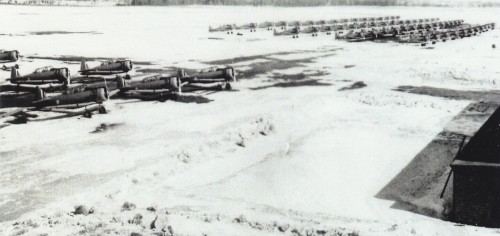
LAC Roy Marshall – September 21, 1941
The 20-year-old son of Lilian Marshall Jones of Lee, London, England, was instantly killed when his Harvard went out of control and crashed into Lake Ontario within a few minutes of taking off on a night flight. Crewmen from the Marine Section immediately went out to attempt a rescue. Sgt. Mark Suggett 513926, the Motor Boat Coxswain, accompanied AC1 William J. Jones 1151309 climbed on the wrecked aircraft in order to lift the body clear of the water. LAC B. Dorman 339815, transport mechanic, and Sgt. Suggett lifted the body into the dinghy. The pilot was not wearing his life-saving jacket.
At the Court of Inquiry, witnesses LAC Alfred Farnham 923967, Deck Hand in Marine Section, and Sgt. John S. Robertson 513476 said the aircraft turned to the right instead of the left after taking off in the direction of Amherst Island Point. Mr. Harvey Sheridan Patterson, a farmer who lived near Sand Bay on Amherst Island, was in bed when at approximately 23.00 he watched the aircraft passing by the window going in a southerly direction at what appeared to be a lower altitude than those that he had previously seen. It then disappeared from view and a few seconds later, he heard the sound of a crash. The newspaper account said there was a heavy fog at the time.
Other witnesses were: LAC John Lee 785068, pupil pilot; A/LA Raymond W. Gibb 85067; Flt Sergeant Hugh R. Wadley; P/O C. A. Moffatt; and F. Lieut. W. B. Mitchell, M.D.
A poem written by a young lady was printed in “The Pioneer.”
JOHNNY ERK
I’ve met Johnny Erk, and oh, how hard he can moan!
Wishing he was “over there,” in a town that he called home;
He joined the Royal Air Force to take part in the fight,
Shipping him to Canada, he didn’t think was right.
He didn’t like our Canada; Kingston – it was dead.
The “dancers” over here were mad; at least, that’s what he said.
The “pictures” they were rotten; the food, he found was bad.
Never blaming for a minute, the erks the Air Force had.
He knew he had his fears, for the folks back over home,
He didn’t like to leave them, to face it all alone.
But the war went on regardless, even with him over here,
And the folks back home, he found, were always full of cheer.
While Canadians are saving, every cent to lend,
He’s grabbing for his pay check, and running then to spend
We pay all our taxes, we’ve learned to understand,
That if victory’s to be ours, we must fight as one great man.
Canadians’ war effort! Pah! He told me we had none,
We were shouldering that heavy burden, over to the next one.
He begrudged the income tax that he was asked to pay,
The least that he could do to help the war along its way.
So! Johnny Erk, though your worries, you think, are deep,
Remember all Canadians here have good cause for to weep.
And many of their mothers have received death at the door,
Saying, with sincere regrets, your son, he lives no more.”
Canadians who have joined up are fighting “over there,”
Where “fags” are mighty scarce, and rations everywhere.
The people of our Canada are sending up a prayer,
For the safety of our boys, who are fighting over there.
Victory shall be ours, and the road, it may be long,
But someday, little Johnny, those tears will turn to song,
So chin up! Chest out! I mean this, if you can,
For goodness sake, stop weeping, Johnny; grow into a MAN.
LIEUT. ROBT. HAMPTON GRAY, V.C.
On October 6, 1941, among the largest class of Canadians to graduate as Fleet Air Arm pilots was 23-year old Robert Hampton (Hammy) Gray from Nelson, B. C.
Two photos with unknown women show Hammy Gray and Hal Tibbetts on the dock at the Gananoque Inn.
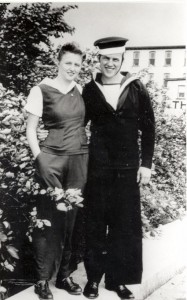
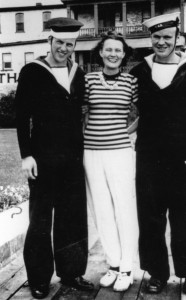
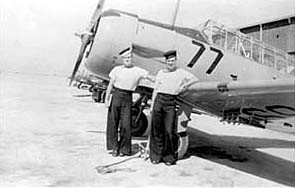
Left in Kingston, Gray and Tibbetts
Also graduating with Gray were the following Canadians, with one American:
F. W. H. Bradley, St. Louis, Missouri; R. B. Dunfield, Toronto; *J. E. Gaunt, Toronto; J. W. Stewart, Montreal; *A. W. Sutton, Saskatoon; H. A. L. Tibbetts, Fort Francis; W. J. C. White, Hamilton; *R. M. Wilson, Regina; and Geo. A. Willis, a former star of Western University’s Mustangs and Toronto Argos. All had enlisted in the R.C.N.V.R. except Dunfield who was R.N.V.R. (*Names on Halifax Memorial; see In Memoriam)
On 9 August 1945, while serving on the British carrier HMS Formidable, Lieut. Gray led an attack against five Japanese warships in Onagawa Bay. Although his Corsair aircraft was struck by enemy fire, he held its course and released his bombs. He was then seen to crash upside down into the sea. One of his bombs struck the destroyer Amakusa sinking it, and the remainder of the flight continued the attack until fifteen more ships were sunk. On that day, the second atomic bomb was dropped.
Lieut. Gray was awarded the Distinguished Service Cross and the Victoria Cross [posthumously. He is commemorated on the Halifax Memorial. His only brother, F. Sgt. Jack B. Gray, R.C.A.F. wireless operator/gunner, had been killed in a crash in Yorkshire on February 27, 1942 as his crew returned from a mission. They were the sons of John and Wilhelmina Gray and were survived by one sister, Phyllis.
Graduating in various classes in 1941 were the following whose names are on the F. A. A. Memorial: Thomas Barr, Clydebank; E. S. Chipperfield; K. G. Codling, Cheshire; W. Courtney, Scotland; P.S. Cowen, Surrey; W. K. Lockwood,Yorkshire; J. McEvoy; A. Moore, Middlesex; (See In Memoriam addendum)
LAC Ernest R. Reynolds – October 28, 1941
LAC Ernest Raymond Reynolds 947432 was struck by a propeller of Harvard AJ690 while on night duty, receiving grave injuries from which he died 10 minutes later. The twenty-two year old was the son of Ernest and Maud Ellen Reynolds of Pype Hayes, Birmingham, England. He was buried with full military honours in the military plot at Cataraqui Cemetery.
This was the first accident of its kind to occur at the station, but not the last. With the number of aircraft operating at night and the noise level, it would prevent someone from distinguishing the noise. At the Court of Inquiry, it was learned that while making his fourth solo landing, LAC D. J. M. Allan 1365875, executed a ground loop without apparent damage and was taxied to the post for inspection. F/O Beaumont detailed a rigger, AC Norman J. Gibson, to examine the aircraft. This was being carried out when LAC Reynolds came up and walked into the airscrew which struck his shoulder, amputating his arm.
Witnesses were A/LA David Ian Miller, pupil of No. 27 Course; F/O W. R. L. Beaumont; LAC N. J. Gibson 624465; S/L Edward Henry Eustace Cross, Sr. Medical Officer, R.A.F.; F/L T. W. Hamlin; F.Sgt. Ambrose Victor Everett; AC1 Norman John Gibson 624445, Flight Rigger; F/L Thomas William Hamlin, Flying Instructor; LAC Dennis Duffill 1158906, Chief Flying Instructor runner, member of flare path party.
The conclusion at the Court was that he had “approached without due care in his eagerness” and the rapidly spinning propeller (airscrew in R.A.F. terminology) would be almost invisible. It was necessary to be cautious and on guard, aware of your surroundings at all times.
Concerning the noise and the complaints they received, former Sgt. John Kendall said: “It was necessary to understand how many aircraft were flying at any given time – one hundred planes would go up by 8:00 a.m. and fly until suppertime and, later, two flights were up doing their night flying training.”
LAC John Oldfield – November 20, 1941
Harvard II AJ701 flown by 22-year-old LAC John Oldfield R.A.F. disappeared during night flying operation and was listed as missing. The airman had been detailed to carry out six solo night landings. After taking off at 00.05 hours, the plane was observed to climb straight to a height of approximately 1000 ft., then to turn slightly to starboard and lose height in a steep dive from which the pilot did not recover. Soon after 11:00 hrs., a report was received from the marine section of oil on the water between Salmon and The Brothers Islands and a pilot reported seeing what might be part of the fuselage. A salvage party from Trenton joined the search but due to low clouds, rain and choppy water, the search was finally called off on December 2. His body was not recovered until August 2, 1942. LAC Oldfield was the son of Sydney and Nellie Oldfield, Harborne, Birmingham, England.
At the Court of Inquiry, it was concluded that the pilot had looked out of the cockpit and in redirecting his attention to his instruments, had lost control and dived into the lake. The inquiry report noted that the absence of any horizon or lights prevented the pilot from obtaining any other aid than that given by his instruments and it was recommended that leading lights be placed in some convenient position off No. 2 runway in a southerly direction and that night takeoffs in that direction be allotted only to well-trained instrument pilots and that weather conditions, if possible, include definite horizon.
The instructors gave few of their pupils high ratings, with most rated as average or below average and only a few showing any particular ability at this stage. They worked to teach even the unteachable – to keep them confident and relaxed and to keep them believing that soon it would all come together. The pupils would hear encouraging words like: “Try again – that was a lot better.”
In his “Suggestions for Night Flying” a pupil spoke for nervous instructors when he suggested “To make pupils feel at home on their first solo, a recording of their instructors’ voices will be placed in the back cockpit. When they feel lonely, they can switch on and be comforted by: “That’s right, you bloody fool – kill both of us!”
Instructors must have shared many an amusing stories about their students. This one is told by Bill Martin, an ex-F.A.A. pilot who trained at Gananoque, and it is at the expense of an instructor:
“My instructor had been recently married and was not anxious to do anything that might hinder his safe return to his bride. Just something as ordinary as a normal landing was now to him a hazardous undertaking. Being overcautious, he pulled up each time I came in for a landing, and continued to do this until I realized I would never graduate at this rate. Eventually, of course, we had to land, and the next day I handed in a formal request to be assigned to another instructor, which request was granted.”
The ground crew had their own anxieties. One duty which caused more high-anxiety than others was placing the “angle of approach indicator” at the beginning of the flare path. This was coloured red, amber and blue and indicated height to the pilot. Coming in to land, if the pilot could see the red light it meant he was in danger of diving into the ground; amber meant it was safe to land; blue indicated sky, which meant he was too high. Once the first landed safely, the airman on duty knew that the others were correct.
In the beginning, the aircraft didn’t have two-way radios and the loneliness of the first solo flight could be unnerving. As one said: “The first solo night flight was especially frightening because then you knew there was only you and your Maker.”
A few instances were recorded of cautious pupils who noticed blue flames coming from their exhausts and, imagining their planes were on fire, carried out forced landings with the undercarriage retracted. The problems did not improve when they returned to the U.K. Peter Roome compared the two experiences: “At Kingston once you were in the air everywhere was lit up and you could see the lights of Watertown across Lake Ontario. The first night back was terrifying, utter darkness everywhere and only moonlight with which to orientate oneself. A complete blackout was in operation and only on the approach to landing were runway lights switched on.”
On December 2, three naval officers, twenty-two naval ratings and sixteen R.A.F. completed training with No. 25 Course, and on the 4th, four naval officers and twenty-five naval ratings arrived for training with No. 22 Course.
On December 29, Course 29 graduated with six officers and forty other ranks successfully completing their training. In the first week of January 1942, four naval officers and forty-six naval ratings reported for training with No. 35 Course. Although it was a large group, not all would necessarily complete the course together. Pupils sometimes had to drop out due to injuries or illness and would then join up with another group.
Twice, within a week, two Harvards collided while taxiing with the airframes being seriously damaged. Another Harvard made a forced landing owing to engine failure and, again, the airframe was seriously damaged. The accidents continued throughout the winter months and the new Harvards they had acquired were regularly damaged in minor as well as serious crashes with some written off. Many stations across the country were in urgent demand for Harvards and the seemingly careless accidents put a strain on the facilities. They were caused by pilot errors and, in many cases, maintenance staff oversights. It was said by those who witnessed such things that service log books would sometimes be filled in even though the plane had not been checked. It was said, though, that No. 31’s record held up and it was rated as one of the best in the country.
As Jim Delaney had foreseen in 1940, the site of the airdrome was dangerous for training inexperienced pilots due to fogs in the marshy area. One who survived his crash was A/LA Allen Burgham of New Zealand. On January 24, 1942, Course 48 consisting of six naval officers and fifty-four naval ratings reported for training. That night a Harvard piloted by A/LA Burgham crashed into woods near the airport due to a rapid fog formation which enveloped the area. He was slightly injured and spent some time in hospital recovering. Upon his release, he joined Course 33, and graduated on April 2, 1942. He had arrived with his group at the end of November, 1941. Courting time was brief for the pupils so fewer friendships with the local girls developed into marriage, but there were exceptions and he was one who returned to Kingston to marry.
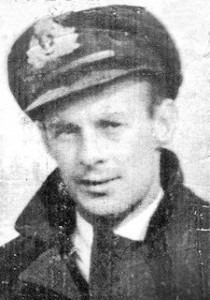
After completing his training in the U.K., Allen Burgham eventually became the Senior Pilot of 835 Squadron, Royal Navy Fleet Air Arm, serving on HMS Nairana on Atlantic, Arctic and Gibraltar convoys and Flight Commander of the Fighter Component. He was twice decorated for “Gallantry in the Face of the Enemy”.
The boys from ‘down under’ were very popular, especially the New Zealanders. Canadian airmen described them as having a casual, friendly manner that made them a pleasure to know. They were well-represented in the B.C.T.P. and the New Zealand War Record states that 650 of their young men served in the Fleet Air Arm.
W/O W. E. Madden, A/LA W. H. Riddett
A/LA C. A. Treble
February 23, 1942
A tragic crash killed an instructor and pupil in one plane, and a lone pupil in another when they collided in mid-air. P/O W.E. Madden, R.C.A.F., and pupil, A/LA W. H. Riddett, were returning to the airdrome while A/LA C. A. Treble, the lone pupil in the other aircraft, was flying in the direction of Sandhurst having just taken off. At a height of about 2000 ft., some two-and-a-half miles to the west of Collins Bay, they collided practically head-on. Both aircraft went into a spin from which they did not recover.
P/O Willard E. Madden, 24, and A/LA Walter Herbert Riddett, 19, were killed when their trainer AJ687 crashed on the property of Bruce Sandercock near Westbrook, Lot 19, Concession 1, Tp of Ernestown. Witnesses were Walter Babcock, a farmer in the area, and Alfred and Oakley Mills of Odessa, but they were unable to be of assistance due to the intense heat.
A/LA Claude Anthony Treble, 19, was killed when his plane crashed nose first into a swamp on the Fairfield farm. It had been driven into such a depth, the farmers were certain it could never be recovered, but equipment brought from the station finally managed to remove it.
Pilot Officer Madden of Dunbarton, son of Rev. and Mrs. F. W. Madden, was buried in Toronto. He had 2000 flying hours logged and was a veteran of the Battle of Britain.
A/LA Riddett was the son of Herbert and Edith Riddett of Nomansland, Wiltshire. A/LA Treble was the son of Ralph John and Annie Mary Treble of Awbridge, Hampshire. The two student pilots are buried in the military section at Cataraqui Cemetery.
Testifying at the Court of Inquiry were: witness A/LA Denis P. Young FX96088; S/L Dennis Arthur Adams, O.C. No. 4 Group; F/O Paul Anthony Barker; F/O Charles Edward Fraser Brown, Engineer Officer.
On February 27,1942, Course No. 31 graduated with one naval officer, thirty naval ratings, and nine R.A.F. airmen receiving their wings. On that day, also, a party of airmen from the station made up the military escort for the funeral of a local boy who was killed in training. He was LAC K. R. Summerville, whose body had been returned from #10 S.F.T.S. in Dauphin, Manitoba. It was less than a month since they had been pall bearers for another Kingstonian, LAC C. F. Clarke, who had been killed in a fiery crash at the end of Earl Street, near the Kingston Peni-tentiary. He was seen to be flying low and one witness was sure he was dipping his wing to identify himself to his family. He was on cross-country flight from #2 S.F.T.S. R.C.A.F. Uplands. Both he and LAC A. C. Cornell were burned to death.
Group Captain H. J. Collins, officer commanding the base since July 12, 1941, was posted to Air Force Headquarters in Ottawa on March 1, and the popular Canadian W/C William Keddie assumed temporary command of the unit. One described W/C Keddie as “a heck of a nice guy; a typical Canadian. The old-school R.A.F. officers had been raised in a class-conscious society and were unapproachable.”
Course No. 50 composed of three naval officers, forty naval ratings, one R.A.F. officer and other ranks commenced training on March 2. No. 33 Course graduated on March 27 with forty-five pupils successfully completing their training. They consisted of one naval officer, thirty naval ratings and nine R.A.F. airmen.
Among those who arrived with Course No. 50 was Peter Roome who shared stories about his time here, his further training in Britain, and on active service. There were no class photos in 1942, but he shared these two:
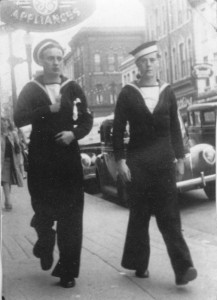
Left: Steve Starkey and Peter Roome walking down Princess Street.
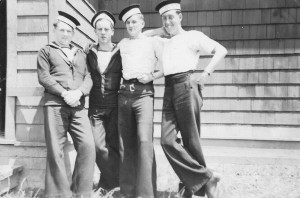
Photo on right L-R: *Frank Squier (died night flying at Yeovilton), Peter Roome, *Bob Lawson, R.N.Z.F.A.A. (killed off Scapa Flow), and Tuck (first name not remembered). (*See In Memoriam)
Peter said that he and Bob Lawson flew down from Yeovilton to Exeter in a Tiger Moth to attend the funeral of Frank Squier. Bob Lawson was killed less than eight months later and his body not recovered.
Peter wrote: “We had been doing exercise attacks against our own fleet and were using jettisonable fuel tanks to increase our range. I had landed on and Bob was making his approach to the carrier when he was waved off for some reason and as he passed the ship, his engine cut out and he went into the sea alongside the ship. He didn’t get out and there was speculation that his jettison tank ran out of fuel.”
On April 1, 1942, the total strength of No. 31 SFTS was: 87 Officers, 19 Warrant Officers, 93 Flight Sergeants, and Sergeants, Other Ranks 881, Civilians 13; Pupil Pilots: Officers 10, Other Ranks 198.
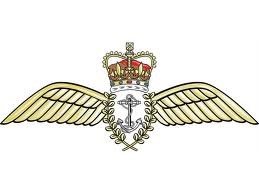
Next Chapter: 15. Construction At Gananoque Airport
Previous Chapter: 13. NO. 1 R.L.G. Will Become A Training Station